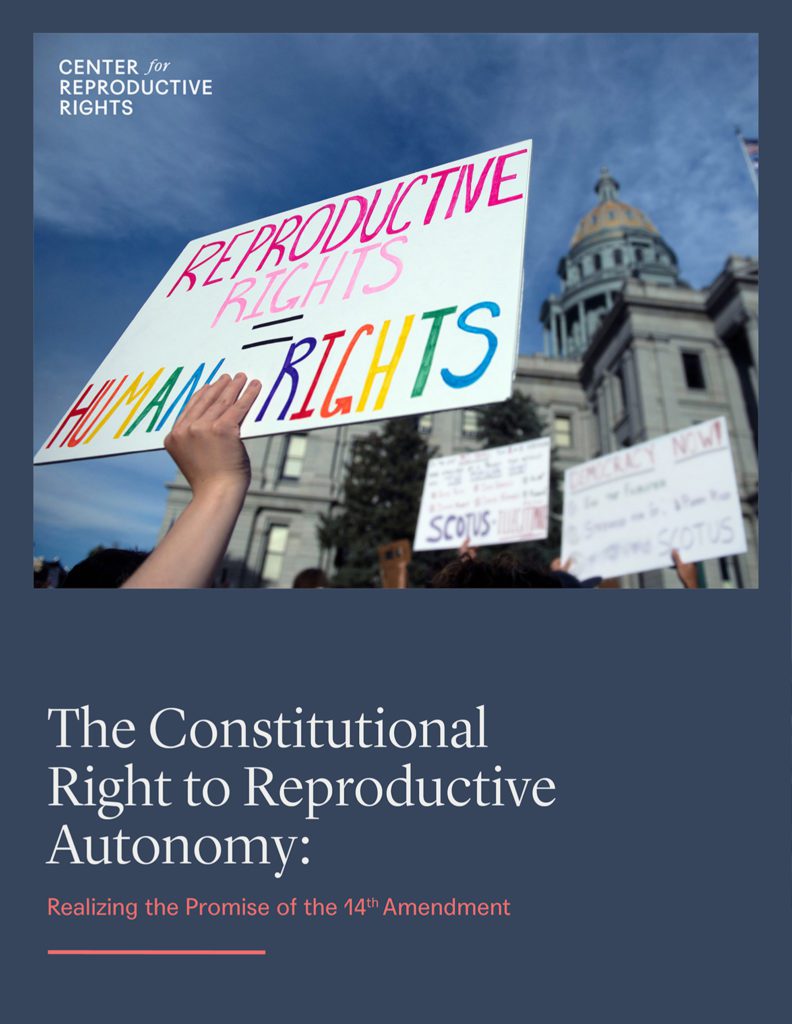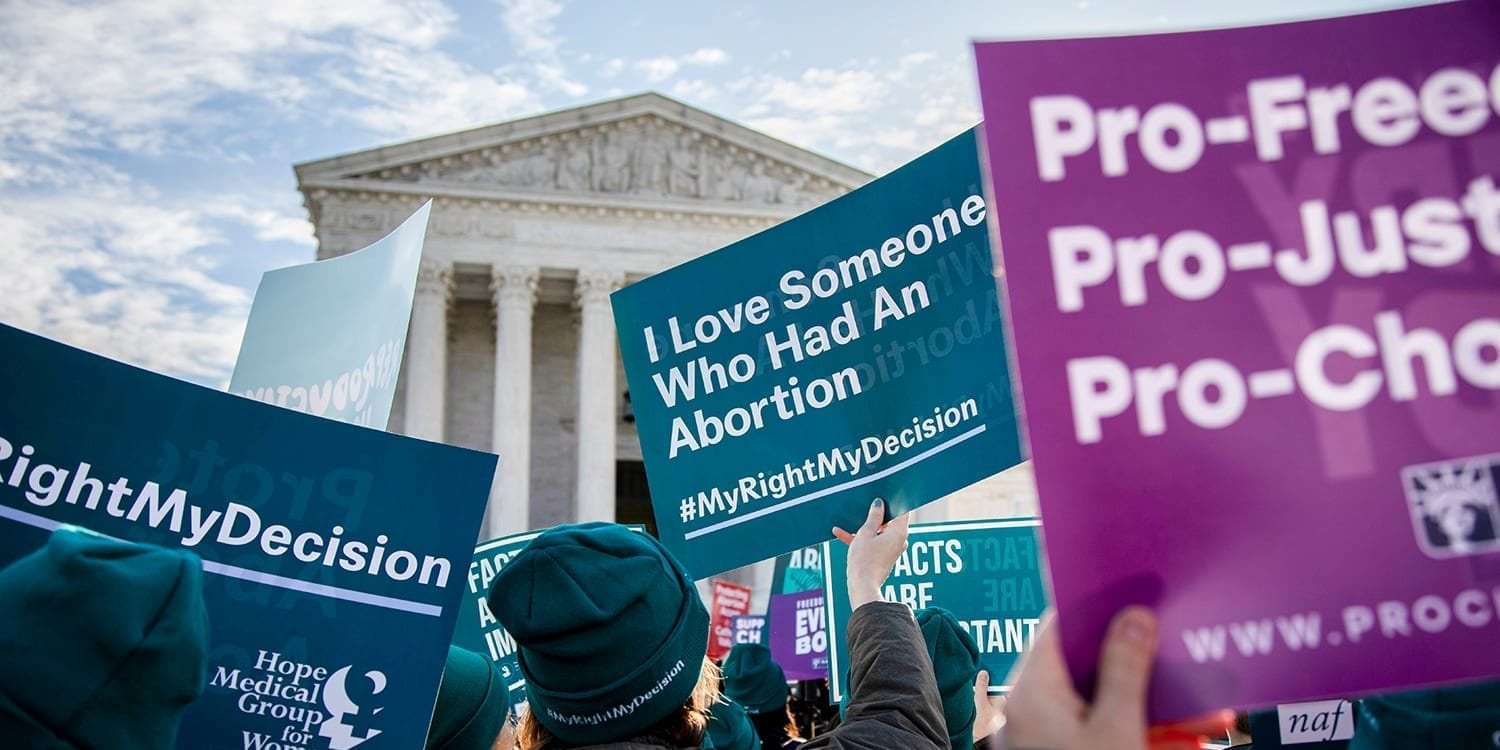
The Constitutional Right to Reproductive Autonomy: Realizing the Promise of the 14th Amendment
Introduction
The Constitutional Right to Reproductive Autonomy: Realizing the Promise of the 14th Amendment
For the first time in history, the U.S. Supreme Court has taken away a right that it had recognized as fundamental to personal liberty: the right to abortion. The Supreme Court, in its ruling in Dobbs v. Jackson Women’s Health Organization, overruled Roe v. Wade and nearly 50 years of constitutional precedent and held that there is no constitutional right to abortion.
Contrary to the majority’s opinion—and as the dissent powerfully explains—the right to reproductive autonomy is deeply grounded in the U.S. Constitution and is about much more than Roe and the right to abortion. In recognizing the constitutional importance of decisions about childbearing, the Supreme Court’s holding in Roe was correct—and like watershed decisions before and after it, Roe grounded reproductive rights in federal constitutional rights of privacy and liberty.
The Supreme Court’s decimation of precedent requires a rebuilding of jurisprudence to align with the promise of the 14th Amendment. While the Amendment’s guarantee against state deprivation of liberty—including a right to privacy and to control one’s body—must remain a core pillar of reproductive autonomy, it should not be the only pillar. Multiple legal rights establish that government restrictions on reproductive autonomy constitute sex, race, and economic discrimination, and that such restrictions can deny people their lives, as well as their ability to live their lives with dignity.
Despite the Supreme Court’s radical and harmful ruling in Dobbs, courts must remain rights-protecting institutions in our democracy—and we must insist that they fulfill their role in ensuring equal justice for all.
A new report from the Center for Reproductive Rights, “The Constitutional Right to Reproductive Autonomy: Realizing the Promise of the 14th Amendment,” delves into constitutional rights and guarantees in U.S. law that undergird the right to reproductive autonomy—and how those principles, along with related jurisprudence, can strengthen reproductive rights going forward.
It draws on instructive international and comparative law, scholarship by leading experts in constitutional and human rights law, the transformative work of reproductive justice advocates, and the Center’s expertise as the only global legal organization dedicated to protecting and advancing reproductive rights as human rights.
The report illuminates:
-
How reproductive oppression is used as a tool to control women, people of color, and people living on low incomes and to perpetuate stereotypes and women’s second-class status.
-
Why reproductive autonomy matters to health, life, and economic and family wellbeing.
-
Jurisprudence protecting reproductive autonomy that can inform future rulings.
-
The ways in which international human rights law protects reproductive autonomy.
-
Constitutional rights to liberty, equal protection, and life and how these principles can strengthen protections for reproductive autonomy going forward.
Highlights of the report follow. To explore these topics and others in-depth, read the full report:
“No State shall make or enforce any law which shall abridge the privileges or immunities of citizens of the United States; nor shall any State deprive any person of life, liberty, or property, without due process of law; nor deny to any person within its jurisdiction the equal protection of the laws.”
United States Constitution, 14th Amendment, Section 1
I. Reproductive Autonomy and Why it Matters
Reproductive autonomy—the power to make and act on decisions about reproduction—is central to how people shape their lives. To enable people to fulfill their reproductive autonomy rights, governments must respect and protect those rights. In the U.S., however, the history of reproductive oppression and modern-day realities confirm the devastating and lasting harms when the government fails to protect the right to reproductive autonomy.
The Historical Context of Reproductive Control
For centuries, the nation’s laws enforced the second-class status of women. Laws and policies perpetuated stereotypes about women’s proper role in society and enforced their second-class status in myriad ways, from limiting women’s ability to own property, vote, pursue an education, work, and participate fully in civic life.
At the same time, laws authorized coercive and brutal means to control the childbearing of women viewed by lawmakers as “unfit”—in particular, Black, Native American, immigrant, and disabled women. Among these policies were the forced childbirth of Black women who were enslaved, forced removal of children from Native American households, racially restrictive immigration policies, forced sterilization, and the denial of public benefits to unmarried women.
Read more about the historical context of reproductive control on page 4 of the report.
Reproductive Autonomy Is Critical to Health, Life, and Economic and Family Wellbeing
Bringing a child into the world, raising and nurturing children, and building families and communities are among the most joyful and meaningful life experiences. At the same time, pregnancy and childbirth carry significant health risks, including death. Thus, pregnancy and childbirth should be safe, healthy, and supported experiences. But today in the U.S., maternal mortality is rising, with disproportionate impacts on Black, Indigenous, and other people of color.
For people who decide to end a pregnancy, abortion is extremely safe, but criminalizing it—as states are doing in the aftermath of Dobbs—will exacerbate this maternal mortality crisis. It will also endanger the economic and social wellbeing of women and their families.
The legalization of abortion after Roe v. Wade had measurable and significant positive impacts on women’s socioeconomic standing and on gender equality overall, enabling generations of women to plan and control if and when to start a family, participate more fully in society, and attain higher levels of education, employment, and economic security.
Read more about the importance of reproductive autonomy on page 7 of the report.
II. Constitutional and Human Rights Bases of the Right to Reproductive Autonomy
Because of the deep and lasting impacts of pregnancy and childbirth on an individual’s life, the right to reproductive autonomy is grounded in the life, liberty, and equal protection clauses of the 14th Amendment. The right is also grounded in international human rights, which promote and protect the dignity and equality of all people.
Courts must be clear that people do not lose their legal rights when they become pregnant or may become pregnant– but have an equal claim to all recognized rights—and must be able to make decisions related to pregnancy and childbearing without government coercion.
The Right to Liberty: Personal Decision Making and Bodily Autonomy
The Supreme Court was correct decades ago when it concluded that the 14th Amendment’s Liberty Clause protects individual decisions about whether and when to have a child. Indeed, for more than 100 years, the Supreme Court has interpreted the Constitution’s textual protection for liberty to include the right to make personal decisions related to family, marriage, and childrearing, as well as the right to control one’s body. Many state courts, interpreting their similar state constitutions, have done the same.
International human rights treaty bodies have likewise made clear that governments must protect, respect, and fulfill the right to make personal decisions, including regarding reproductive capacity.
The Supreme Court’s decision in Dobbs to excise the right to abortion as a component of personal liberty was wrong and undermines decades of jurisprudence about the meaning of liberty, including cases recognizing rights to contraception, sexual intimacy between consenting adults, and to marry the person of one’s choice.
Read more about the 14th Amendment’s right to liberty on page 16 of the report.
The Right to Equal Protection and Freedom from Discrimination
Government control of reproductive capacity has long persisted as a tool to subordinate women, people of color, people living on lower incomes and other disfavored groups. The Supreme Court has acknowledged aspects of this history, and a body of judicial opinions and scholarship confirms that a correct understanding of the right to equal protection prohibits the government from regulating people who are pregnant or who have the capacity to become pregnant in these discriminatory ways. International human rights law reinforces robust protections for the right to equality and non-discrimination.
- Sex Stereotyping and Gender Discrimination—Under current federal constitutional standards, laws that discriminate on the basis of sex are subject to heightened scrutiny. Such laws are unconstitutional if they are based on stereotypes about men, women, and traditional gender roles, or if they otherwise perpetuate the second-class status of women. Because government control of decisions related to reproduction and pregnancy perpetuates the legal, social, and economic inferiority of women, these laws are a form of sex discrimination subject to heightened scrutiny.
- Race Discrimination—The constitutional guarantee of equal protection also requires redressing reproductive oppression targeting Black women and other people of color and the ongoing impact of systemic racism on reproductive health and rights. Building on and moving beyond existing case law under the Equal Protection Clause, courts can and should address both the discriminatory intent and impact of laws and policies denying Black women and other people of color the equal right to reproductive autonomy.
- Economic Inequality—Seminal Supreme Court decisions recognize that courts can hold governments accountable for remedying the laws, systems, and institutions that discriminate against people living on lower incomes or in poverty, especially when liberty and family relationships are at stake. Under equal protection analysis, courts should apply heightened scrutiny to all policies that deprive people struggling to make ends meet of decisional autonomy, dignity, and non-discriminatory health care during pregnancy, childbirth, and postpartum.
- Intersecting Forms of Discrimination and Interdependent Rights—Courts also should apply heightened scrutiny to intersectional claims under the 14th Amendment. First, courts can apply legal frameworks that recognize and address the multiple and intersecting forms of discrimination marginalized groups experience. Second, when the state discriminates against traditionally subordinated groups seeking to make deeply personal and intimate decisions, courts can build on Supreme Court precedent recognizing that the protections of the Liberty and Equal Protection Clauses are mutually reinforcing. In these ways, an intersectional analysis drawing on reproductive justice and human rights frameworks can provide a stronger legal framework for securing the equal right to reproductive autonomy for all.
The Right to Life of the Pregnant Person
International human rights law recognizes that the right to life provides critical protections for reproductive autonomy. While underdeveloped in U.S. jurisprudence, a growing body of scholarship looks at the ways government interference with personal decisions about pregnancy and medical care threatens a person’s constitutional right to life.
Thus, challenges to state policies or official actions that threaten the health, safety, and lives of individuals who are pregnant, giving birth, and postpartum as violations of the right to life are ripe for development. An important guide in doing so is the strong recognition under human rights law of the right to life as a critical protection for reproductive autonomy.
Read more about the 14th Amendment’s right to life on page 41 of the Report.
Conclusion
The U.S. Constitution requires the government to respect—and courts to protect—the human right to reproductive autonomy. The 14th Amendment ensures this through its multiple and interdependent guarantees of life, liberty, and equal protection—as does international human rights law. Each of these foundational sources supports a broad right to reproductive autonomy that advocates, scholars, and jurists must not only defend against further retrogression, but also strengthen for future generations.
Read the complete report here:
Read more.
U.S. Supreme Court Takes Away the Constitutional Right to Abortion
On June 24, 2022, U.S. Supreme Court abandoned its duty to protect fundamental rights and overturned Roe v. Wade, ruling there is no constitutional right to abortion. The decision marks the first time in history that the Supreme Court has taken away a fundamental right. Read more here.
State Constitutions and Abortion Rights: Building Protections for Reproductive Autonomy
Learn how state supreme court cases have resulted in broader protections for abortion rights and access and influenced outcomes in other cases and courts—and how this jurisprudence can expand and shape further efforts to secure reproductive rights. Read more here.
Legal Analysis: What Dobbs Got Wrong
This briefing paper by the Center for Reproductive Rights analyzes the majority, concurring, and dissenting opinions in Dobbs. Read more here.


